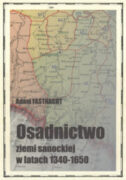Osadnictwo ziemi sanockiej w latach 1340-1650, Instytut Historii im. Tadeusza Manteuffla PAN jest dostępne na licencji:
Creative Commons Attribution-NoDerivatives 4.0 International (treść)
Osadnictwo ziemi sanockiej w latach 1340-1650, Instytut Historii im. Tadeusza Manteuffla PAN jest dostępne na licencji:
Creative Commons Attribution 4.0 International (dane)
Niniejszy materiał bazuje na publikacji Adama Fastnachta (1913–1987), pt. “Osadnictwo ziemi sanockiej w latach 1340–1650” wydawanej dwurktonie: po raz pierwsze w 1962 roku, a po raz drugi, jako przedruk, w 2007 roku1. A. Fastnacht większość naukowego życia poświęcił historii ziemi sanockiej: większość prac nad omawianą książką wykonał jeszcze przed II wojną światową. Był także autorem trzytomowego “Słownika historyczno-geograficznego ziemi sanockiej w średniowieczu” wydanego w latach 1991–20022.
Na podstawie załączonej do książki mapy opracowana została baza danych przestrzennych. W jej skład wchodzą trzy warstwy: sieć osadnicza w postaci punktowo oznaczonych miejscowości, drogi oraz granice zaznaczone jako obszary (poligony). Struktura bazy danych została oparta na legendzie dołączonej do mapy. Odnośnie do miejscowości zawiera takie informacje jak: typ i chronologia powstania osad oraz prawo lokacyjne. Obiekty znajdujące się na mapie zostały wprowadzone do bazy w modelu wektorowym po jej uprzedniej kalibracji (georeferencji). Tak na mapie, jak i w bazie danych znajduje się 482 miejscowości. Każda z nich opisana jest czterema atrybutami: nazwą, typem, okresem powstania (chronologią) oraz rodzajem prawa lokacyjnego Na mapie mamy zatem 18 miast, 461 wsi oraz 3 zamki (dla tych ostatnich nie informacji o dacie powstanie oraz, co jasne, o prawie lokacyjnym). Jeśli chodzi o kompletność atrybutów, to jedna osada nie ma nazwy, a dla 167 nie została podana informacja o prawie lokacyjnym. Granice wyrysowano wprost z mapy, ale ich przebieg na zachodnich i północnych fragmentach łączących się z granicami ziem polskich Korony zostały uzgodnione z przebiegiem opracowanych w ramach “Atlasu historycznego Polski. Mapy Szczegółowe XVI wieku”. Na mapie przedstawiono granice ziemi sanockiej w dwóch przedziałach czasowych: ok. 1400 r. i ok. 1600 r. i takie też dwie warstwy oddajemy do dyspozycji. W bazie danych znajdują się także drogi, które w legendzie do mapy oznaczone są jako “ważniejsze drogi”.
Tomasz Panecki
- Adam Fastnacht, Osadnictwo ziemi sanockiej w latach 1340–1650, Wrocław 1962; Adam Fastnacht, Osadnictwo ziemi sanockiej w latach 1340–1650, Sanok 2007. Do niniejszego opracowania wykorzystano edycję z 2007 roku.[↩]
- Adam Fastnacht, Słownik historyczno-geograficzny ziemi sanockiej w średniowieczu, do druku przygotowali Anna Fastnacht-Stupnicka, Antoni Gąsiorowski, cz. 1, Muzeum Regionalne PTTK w Brzozowie, Brzozów 1991; cz. 2, Stowarzyszenie Małopolski Uniwersytet we Wzdowie, Instytut Europejskich Studiów Społecznych w Rzeszowie, Muzeum Regionalne im. Adama Fastnachta w Brzozowie, Brzozów-Wzdów-Rzeszów 1998; cz. 3, Societas Vistulana, Kraków 2002. por.: http://www.slownik.ihpan.edu.pl/[↩]
